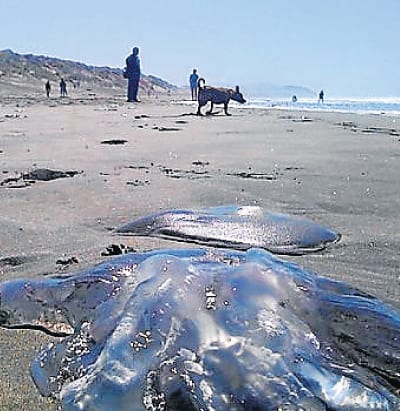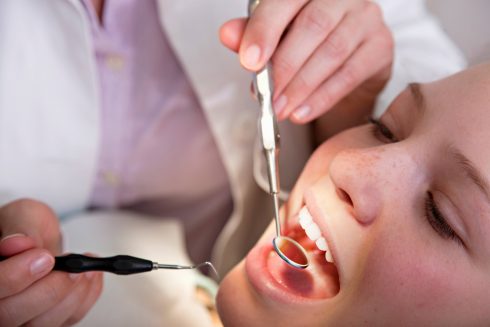DOZENS of beaches in Malaga province have played host to swarms or ‘blooms’ of jellyfish this summer, closing several beaches in Marbella and Estepona and administering more than 1,000 stings within a three-day period.
Many bathers have been on the wrong end of the gelatinous varmint, whose sting causes a painful rash that can last for up to three days.
According to Spain’s tourist office, the marine stingers are the venomous purple striped jellyfish.
Their stings, although almost never fatal, have been known to cause severe allergic reactions.
Here, the Olive Press looks at the different types of stingers in the Mediterranean, why they are becoming such a problem for bathers on the Costa del Sol and what can be done to protect yourself from eye-watering stings.
Purple-striped jellyfish – aka mauve stingers: These increasingly common creatures have wreaked havoc on the Costa del Sol, causing the closure of a number of beaches. They are usually small but pack a powerful punch.
These translucent creatures are often sold commercially as pets
Portuguese man o’ war – aka blue bottle: Although not technically jellyfish, these critters can deliver an agonising sting causing vomiting and fainting in some cases. They are usually found floating at the surface of the water with long, thin tendrils extending 10 metres.

Fried egg jellyfish: A small but beautiful jellyfish which gets its name from its fried-egg shaped body. Its sting has little effect on humans.
Moon jellyfish: One of the most common jellyfish in the world, these translucent creatures are often sold commercially as pets. The sting is harmless to humans.
Compass jellyfish: With brown spots and a saucer-shaped bell, this jellyfish can often be found drifting on the sea surface. It can deliver a nasty sting.
Jellyfish sting symptoms:
- Painful and itchy rash around the affected area
- Raised welts sometimes accompany the rash
- Nausea and vomiting
- Muscles spasms and abdominal pain
- The lymph nodes may swell and turn red in the case of an allergic reaction to the sting
- Severe reactions can cause breathing difficulties and (rarely) death
What to do if you’ve been stung:
- Bathe the area with a generous helping of vinegar for 15 minutes
- If vinegar is not at hand use salt water, not fresh water, to clean out the area
- Remove the stinging tentacles with tweezers – do not attempt to remove them with fingers as this can lead to further stings
- Shave the area with a razor or scrape it with a credit card to ensure all the debris from the jellyfish is removed
- Eye stings should be rinsed out with saline solution. The area around the eye can then be bathed in vinegar. Do not put vinegar directly onto your eyes
- If you suspect you’re having an allergic reaction to the sting, go straight to a doctor
Click here to read more News from The Olive Press.









“Here, the Olive Press looks at the different types of stingers in the Mediterranean, why they are becoming such a problem for bathers on the Costa del Sol and what can be done to protect yourself from eye-watering stings.”
I don’t see anything in the article (as promised= about how to protect yourself?!?!
Are these affecting La Cala beach does any one know?
Also is the dog owner being sought?
“I don’t see anything in the article (as promised= about how to protect yourself?!?!”
Easy, don’t swim.
The predator of the jellyfish is the sea turtle, but unfortunately with the surge of shipping in the area, a lot of these are being hit by ships’ propellors or caught up and suffocated in fishing nets or have died from ingesting plastics (these would look like jellyfish floating about in the water to these creatures) which are indiscriminately and thoughtlessly dumped on the shoreline or in the sea itself. Quite a few have turned up dead covered in oil on beaches in Spain, others found injured on the shore have been saved and are being taken care of in specialised areas to be released back to the sea once recovered. Over 231 of these magnificent creatures have been looked after since 2008 in the Cadiz alone.
“http://www.europasur.es/article/maritimas/1056603/mas/hospital/para/tortugas.html”
Every action man takes which disturbs the natural ecological chain of the seas and its inhabitants brings about a reaction from nature. Then we complain when things aren’t how they should be!
Inthename writing sense as usual
the sea off la Cala in early July was the dirtiest I have seen it – certainly in the last 10 years. As a result the Town Hall has moved quickly to obtain a special sea ‘mop’ to deal with as much as possible in order not to damage the cash cow. Hopefully this has proved successful whilst not curing the root